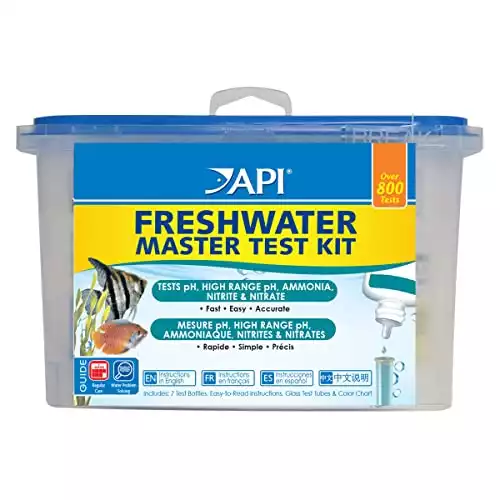
Find out how to assemble the ultimate algae-eating crew including fish, shrimps, and snails.
Plus, get my 5 top tips for other ways to avoid algae taking over!
Which Is The Best Algae Eater For My Aquarium?
You need to pick an algae eater based on your tank setup and the type of algae you have, consider the following:
What type of algae do you have?
Some fish will only eat certain types of algae.
I’ve put under each fish which algae they prefer to eat.
What water parameters does your tank have?
Pick an algae eater that can thrive in your current aquarium setup.
If you have a cold water tank, it’s no good picking an algae eater that thrives in warm water.
What fish do you already have in your tank?
Choose an algae eater that is similar in size and temperament to your other fish.
Algae Eating Fish, Snails & Shrimp
Here are some of the best freshwater algae eaters you can add to your aquarium.
1. Black Mollies

- Name / Scientific Name: Black Molly / Poecilia latipinna
- Care Level: Moderate
- Temperament: Peaceful
- Maximum Size: 4 inches
- Minimum Tank Size: 30 gallons
- Diet: Omnivore
- Water Temperature: 68°-82° F
- dKH: 10-25
- pH: 7.2-8.5
A very popular generally peaceful community fish that will live with other peaceful fish, but they can be a bit boisterous with timid fish. As the name suggests, they are all black but you can find some with a yellow stripe on their dorsal fin.
Hardy and able to adapt to a wide range of water parameters, they do prefer a more alkaline PH, I find they do best at around PH 8. They like a large aquarium with a slow current and plants so they’ve lots of places to hide and still have room to swim as they’re highly active.
Like most other fish, males can be aggressive to other males. Females can get harassed by males wanting to mate with them if they’re outnumbered.
If you want to breed them, keep a ratio of 3 females to 1 male to stop your females from getting stressed.
Be aware it’s very difficult to stop them from breeding so keep females only to avoid this.
It’s very easy to tell the male and female mollies apart.
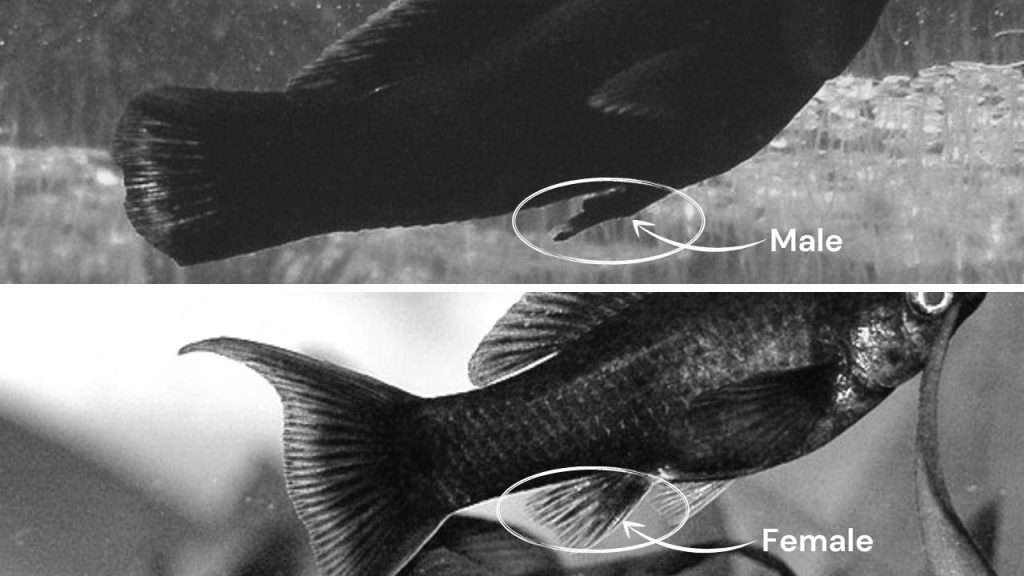
Black mollies will gently nibble away at your algae, in particular hair algae, but other fish on this list will do a better job if your algae growth is particularly bad.
Their diet should include brine shrimp, bloodworms, and daphnia. You can also feed them green vegetables such as blanched zucchini, shelled peas, and cucumber.
2. Bristlenose Plecostomus
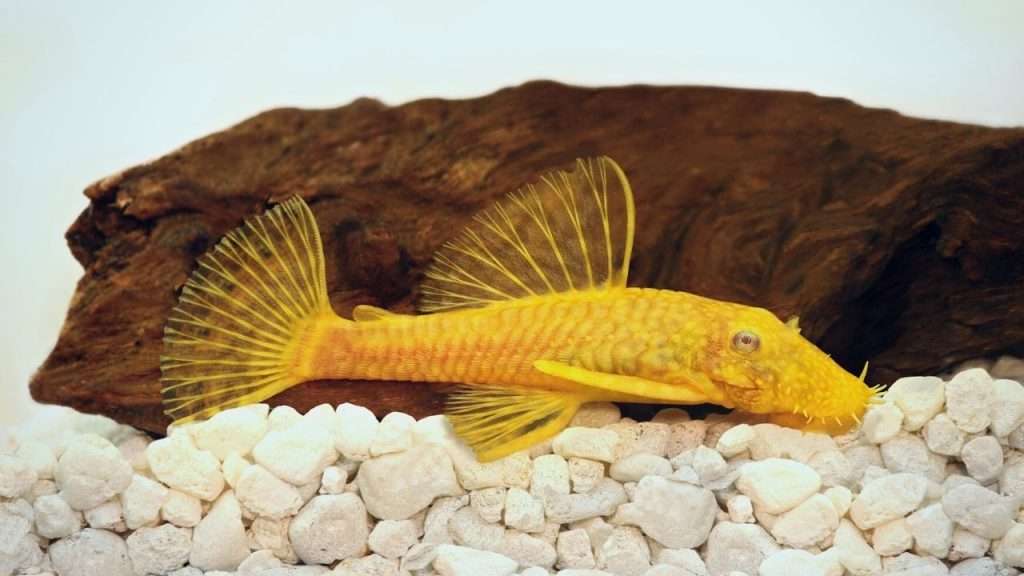
- Name / Scientific Name: Bristlenose Plecostomus / Ancistrus sp.
- Care Level: Easy
- Temperament: Peaceful
- Maximum Size: 6 inches
- Minimum Tank Size: 30 gallons
- Diet: Omnivore
- Water Temperature: 72°-82° F
- dKH: 6-10
- pH: 6.5-7.5
Also known as the bushy nose pleco, a hardy fish that can withstand a wide range of water parameters. Very distinct looking, full of personality, and available in a variety of colors.
They are one of the smallest types of catfish. Make sure you don’t buy the common pleco by mistake as they grow up to 3 feet!
Great for a community tank as they are peaceful and won’t bother your other fish. They get along fine with other algae eaters like snails and other grazing fish.
Some male bristlenose can be territorial with each other, so make sure there’s enough space so each of them can claim their own spot.
Brislenose plecos really appreciate having driftwood in their tank, as they eat it and it aids digestion. You can buy supplements that contain wood if you don’t have any driftwood in your tank.
These guys are bottom dwellers and spend most of their time eating the surface algae off the substrate, decorations, and plants. They will often stick themselves to the side of the tank to eat the surface algae off of the glass, which is fun to watch.
Being nocturnal they are most active at night. They like plenty of hiding spaces amongst driftwood and plants to relax during the day. They prefer a faster water flow through the aquarium as this simulates their natural wild habitat and also keeps the water properly oxygenated for them.
The bristlenose pleco does produce quite a lot of poop as they are very greedy, what goes in has to come out! Although they eat a lot of algae, this alone won’t sustain them. You will need to feed them other food like frozen bloodworms, sinking pellets, flake food, Repashy gel food, and blanched vegetables like zucchini and green beans.
As with all bottom dwellers, make sure their food is reaching the bottom of the tank or you risk them not eating enough. A well-fed pleco will be brightly colored and its stomach shouldn’t be sunken, so it’s easy to tell if they’re not eating enough.
3. Chinese Algae Eater
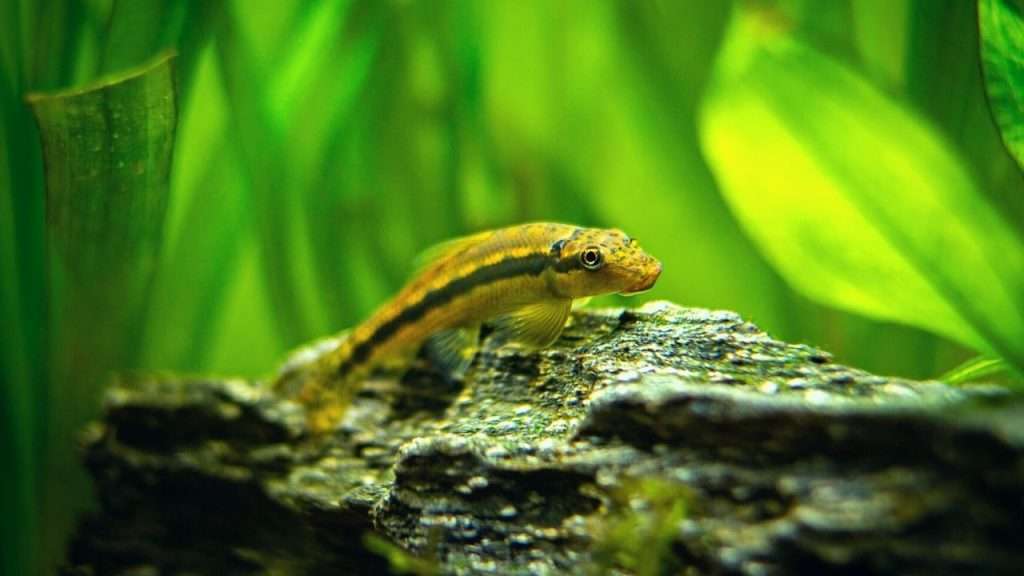
- Name / Scientific Name: Chinese Algae Eater / Gyrinocheilos aymonieri
- Care Level: Easy
- Temperament: Semi-aggressive
- Maximum Size: 10 inches
- Minimum Tank Size: 30 gallons
- Diet: Herbivore
- Water Temperature: 74°-79° F
- dKH: 8-10
- pH: 6.8-7.4
Not the most colorful fish you’ll ever see, they’re brown with a black stripe and a bit bland looking. I was in 2 minds about whether to add this fish due to my own experience with them, but these bottom-dwelling fish do a great job of eating algae, so I’ve included them.
If you want something purely to deal with algae then this fish will do just that. It will eat algae until the cows come home, but there are some drawbacks. They are easy to care for and have a long life span of around 10 years, so what’s the problem…?
The problem is that they’re intolerant of their own species and other tank mates of a similar size and/or appearance. The older they get the more aggressive they get and the less algae they eat, preferring other readily available food that you feed your other fish. I’ve also had issues with them latching on to other tank mates and nibbling at their protective mucus coat layer.
That being said, I do know someone who has 3 Chinese algae eaters in a 180-gallon tank with no issues at all. They are kept with larger fish (tinfoil barbs, a clown loach, a geophagus, and a bala shark). It’s probably because these larger fish keep the CAE in line due to their size, so choose tankmates wisely.
4. Florida Flagfish

- Name / Scientific Name: Florida Flagfish / Jordanella floridae
- Care Level: Easy
- Temperament: Semi-aggressive
- Maximum Size: 2.5 inches
- Minimum Tank Size: 10 gallons
- Diet: Omnivore
- Water Temperature: 66°-72° F
- dKH: 6-20
- pH: 6.7-8.2
Also known as the American flagfish, they are easy to care for, hardy, and peaceful fish. Vibrantly colored having a resemblance to the Star-Spangled Banner.
Males are more vibrant than females and females have a black dot on their dorsal fin. Younger fish in the store won’t have this coloration, but it will develop as the fish matures. Using a darker substrate will really make their color stand out.
Great for a community tank as they are generally peaceful with other peaceful fish. I recommend fast-swimming tankmates as they can nip at the fins of slower-moving fish, like fancy goldfish.
As schooling fish, they prefer to be in a group of 5 or more. Males can become territorial during mating season. Using plants and decorations to break up the line of sight and providing hiding places so they can hang out in their own area should stop you from having any issues.
These guys prefer a slower flow of water in the tank and will become stressed if it’s too fast. Another must is a tight-fitting lid as they are known jumpers!
They are particularly fond of hair algae and black beard algae. Not a picky eater and will take almost anything you put in the tank. Great for algae control but will also eat vegetables like blanched zucchini and spinach. Brine and mysis shrimp can also be fed in moderation.
When the algae start to run low, feed them algae based fish food as this will save them from nibbling at your aquarium plants.
5. Otocinclus Catfish
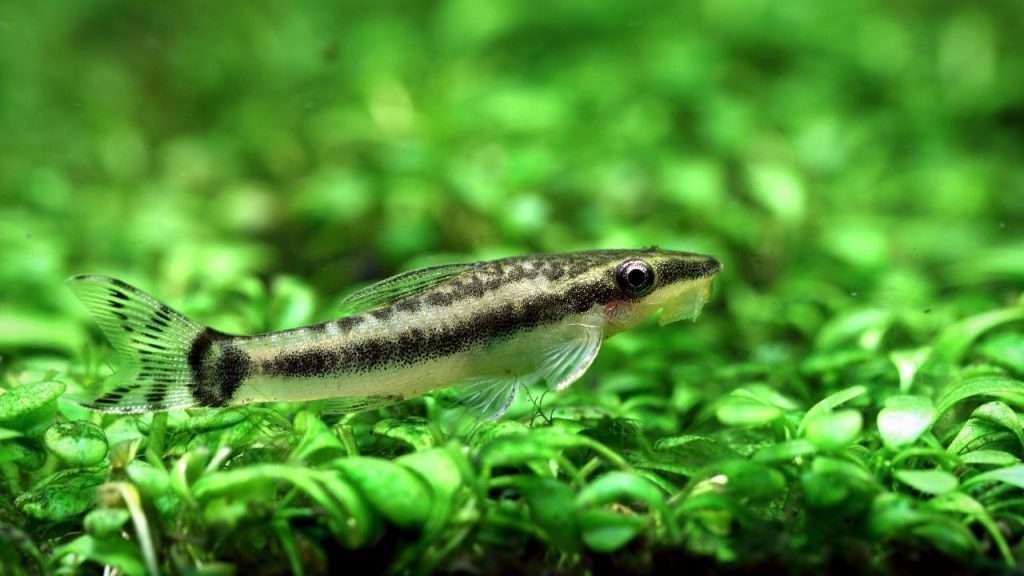
- Name / Scientific Name: Otocinclus Catfish / Otocinclus sp.
- Care Level: Advanced
- Temperament: Peaceful
- Maximum Size: 2 inches
- Minimum Tank Size: 10 gallons
- Diet: Herbivore
- Water Temperature: 73°-79° F
- dKH: 6-10
- pH: 6.8-7.5
The most peaceful fish I have ever come across, they don’t have a bad bone in their body.
Oto’s are sociable so need to be in a group, I would get a minimum of 5, and although they are small they will need a larger tank so that they have enough algae to nibble at, their appetite for algae is insatiable!
They prefer a softer substrate and they need plenty of plants as they will provide lots of surface area for them to eat algae off. They thrive in pristine water, aim for 0 ammonia, 0 nitrites, and 0-20ppm nitrate.
Being small (growing to a maximum of 2 inches) they can be eaten by larger fish, with this in mind choose peaceful tank mates that aren’t too large or boisterous.
Their diet is mostly soft brown algae and aufwuchs, but a well-maintained aquarium won’t provide enough algae to keep a group of oto’s going.
They are known to be picky eaters so you’ll have to figure out what they like, I’ve had ones that will eat algae wafers and some that won’t touch them. Mine particularly like blanched zucchini and their favorite is canned green beans (no added salt), they’ll also eat Repashy Soilent Green.
Sadly, oto’s are one of the most commonly mistreated fish sold in stores, they are caught by the thousands in the wild in South America and are often left without food in terrible water conditions before they arrive at the fish store.
I know plenty of people who have bought them from fish stores and had them die in under a week. Unfortunately, most oto’s are malnourished by the time they make it to the store, so it’s important you check the oto’s belly isn’t sunken, it should be slightly rounded.
If possible buy tank bred oto’s as they’ll be much healthier.
6. Red Garra aka Doctor Fish
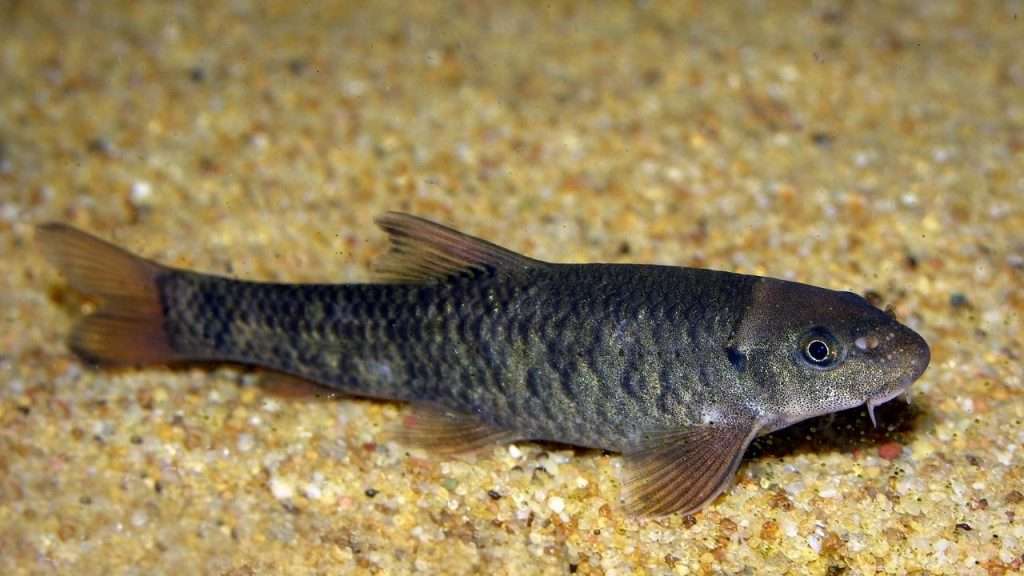
- Name / Scientific Name: Red Garra / Garra rufa
- Care Level: Moderate
- Temperament: Semi-aggressive
- Maximum Size: 5.5 inches
- Minimum Tank Size: 50 gallons
- Diet: Omnivore
- Water Temperature: 61°-82° F
- dKH: 6-16
- pH: 6.5-7.5
Fairly easy to care for if they have the right environment, they like fast-flowing water that is well-oxygenated and with well-maintained stable parameters.
Generally peaceful with other fish, but can be aggressive towards their own kind or similar looking species, best kept in groups of 5 or more to reduce squabbling.
The red garra isn’t suitable for a new aquarium setup, make sure you only add them to a well-established tank where there is already plenty of biofilm and algae for them to eat and the water parameters are more stable.
Supplement their diet with things like spirulina flakes, bloodworms, and brine shrimp. They’ll also eat green blanched veggies like spinach, cucumber, and zucchini.
A tight-fitting lid with no small gaps is a must as the red garra can climb your tank sides and escape. Provide plenty of plants, rocks, and driftwood for them to nibble algae off and allow each fish to claim its own hiding place where it can rest.
The name ‘doctor fish’ comes from its use in beauty spas to pedicure people’s feet by eating the dead skin off them. Thankfully, this practice has been made illegal in many countries, as it’s considered cruel. To condition the fish to eat the dead skin they have to be starved!
7. Reticulated Hillstream Loach

- Name / Scientific Name: Reticulated Hillstream Loach / Sewellia lineolata
- Care Level: Easy
- Temperament: Peaceful
- Maximum Size: 3 inches
- Minimum Tank Size: 30 gallons
- Diet: Omnivore
- Water Temperature: 65°-76° F
- dKH: 10-15
- pH: 6.5-7.5
The reticulated Hillstream Loach has a lot of misinformation on the internet. You’ll see many websites saying they need cool high-flowing water, so I avoided keeping them for years as my tank wasn’t suitable, but then I started to see people successfully keeping them in ‘regular’ aquariums without high-flowing water. So I gave it a go and based on my experience of keeping these guys, they’re actually super easy to care for and they are thriving in my community tank.
They’re quirky looking, almost like miniature stingrays. Some people say they’re a bit oddball, which is probably why I like them so much!!
They’re generally very peaceful with other peaceful fish that don’t fin nip. I recommend you get either 1, or a small group of 3. You will see the males squabble with each other, but they never harm each other as it’s only belly-to-belly posturing.
These fish need to be added to a well established aquarium with plenty of biofilm and algae to nibble away at, they also like plenty of plants.
They are particularly fond of green and brown algae, they’ll eat algae off pretty much anything, including your sponge filter. You may even find them inside your HOB filter as there’s a ton of food in there for them, so be sure to check in there if they go ‘missing’.
They will also eat insect larvae, brine shrimp, daphnia, fish pellets, algae wafers, and Repashy Soilent Green.
A tight-fitting lid is a must as these guys will climb the sides of the tank and escape.
8. Rosy Barb

- Name / Scientific Name: Rosy Barb / Puntius conchonius
- Care Level: Easy
- Temperament: Semi-aggressive
- Maximum Size: 6 inches
- Minimum Tank Size: 30 gallons
- Diet: Omnivore
- Water Temperature: 64°-72° F
- dKH: 4-10
- pH: 6.0-7.0
A very active and hardy fish. Males are more vivid in color and have a lovely shimmering reddish-pink coloring, whereas females are less vivid and are more gold or silver in appearance.
Peaceful when kept in a small school of 5 or more. They like the company of their own kind and will become stressed if there aren’t enough of them.
Tankmates should be of a similar size, as smaller fish may end up getting eaten. You should avoid slow swimming long-finned fish as tankmates as the rosy barb is a fin nipper.
The rosy barb is particularly fond of hair algae, and will also eat algae off your plants, but be aware that they will nibble away at any soft-leaved plants.
They will also eat meaty foods such as brine shrimp, bloodworms, and insects. Veggies such as blanched zucchini and peas will also keep them happy.
Rosy barbs are very capable jumpers so make sure you have a tight-fitting lid on your tank.
9. Rubber Lipped Pleco

- Name / Scientific Name: Rubber Lipped Pleco / Chaetostoma milesi
- Care Level: Easy
- Temperament: Peaceful
- Maximum Size: 5.5 inches
- Minimum Tank Size: 30 gallons
- Diet: Omnivore
- Water Temperature: 72°-80° F
- dKH: 8-12
- pH: 6.5-8
One of the most peaceful freshwater fish out there. Being very hardy, the rubber lipped pleco is super easy to care for and can live for up to 12 years. House them with other non-aggressive tank mates.
The rubber lipped pleco is particularly fond of the dreaded black beard algae. You will need to supplement their diets as algae alone isn’t enough to sustain them.
Algae wafers and blanched veggies like zucchini, cucumber, peas, spinach, green beans, and Repashy food will give them a varied diet.
Soft sand would be preferable to gravel as your substrate, to avoid scratching your pleco’s belly. Driftwood is a perfect addition to the tank for these guys, not only providing them with a hiding place but also a food source as algae will grow on the surface.
These guys are not very active fish and move very slowly around the bottom of your tank. They’re quite shy and stay hidden amongst your plants and decorations for most of the day.
10. Siamese Algae Eater

- Name / Scientific Name: Siamese Algae Eater / Crossocheilus siamensis
- Care Level: Easy
- Temperament: Peaceful
- Maximum Size: 6 inches
- Minimum Tank Size: 30 gallons
- Diet: Omnivore
- Water Temperature: 75°-79° F
- dKH: 5-20
- pH: 6.5-8.0
The Siamese algae eater has a 2 tone grayish-brown coloring and a black stripe running from its nose to its tail.
There are 3 other fish that look similar to the SAE and they are often mislabeled in fish stores, so you can easily end up with the wrong kind of fish that won’t touch your algae! A true SAE will have clear fins, apart from its caudal fin (tail) where there will be some continuation of the black stripe.
I’ve done a handy comparison picture to make it easier to identify that you are buying the correct fish:
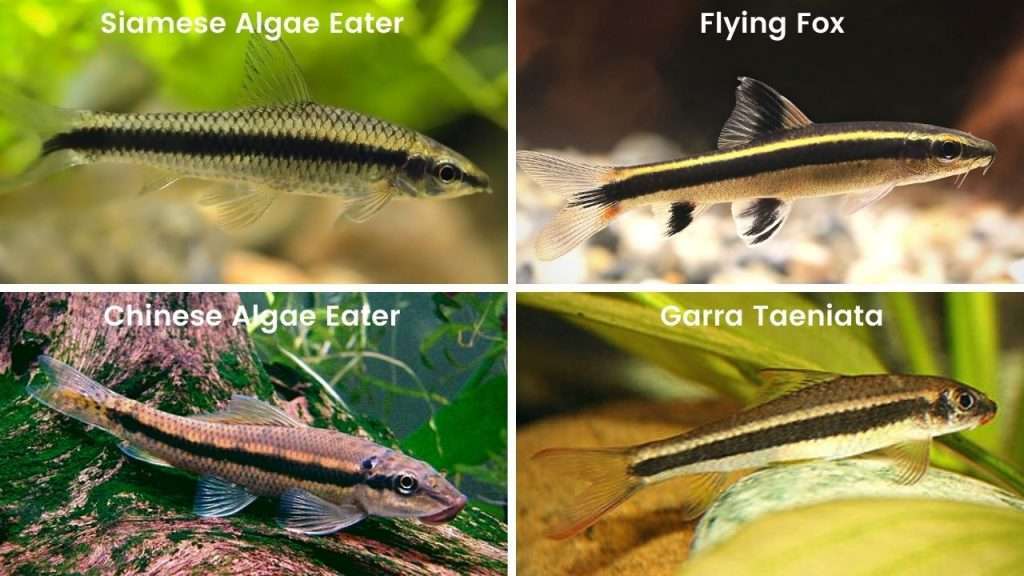
Super easy to care for as they’re able to withstand a wide range of water parameters and can live for up to 10 years.
They’re peaceful with their own kind and other peaceful community fish. You should keep either a single SAE or a group of at least 5, a smaller group will result in territory squabbling.
They will eat the dreaded black beard algae, which is always a plus! They’re also great for getting algae off your aquarium plants without damaging them.
Other foods to feed them include blanched veggies like spinach, zucchini, sinking catfish pellets, and algae wafers.
They are always on the move and active, due to the fact they lack a swim bladder, so make sure to provide them somewhere to shelter when they want to rest, driftwood, plants, or caves are ideal.
A tight-fitting lid is a must as they are known as jumpers.
11. Twig Catfish
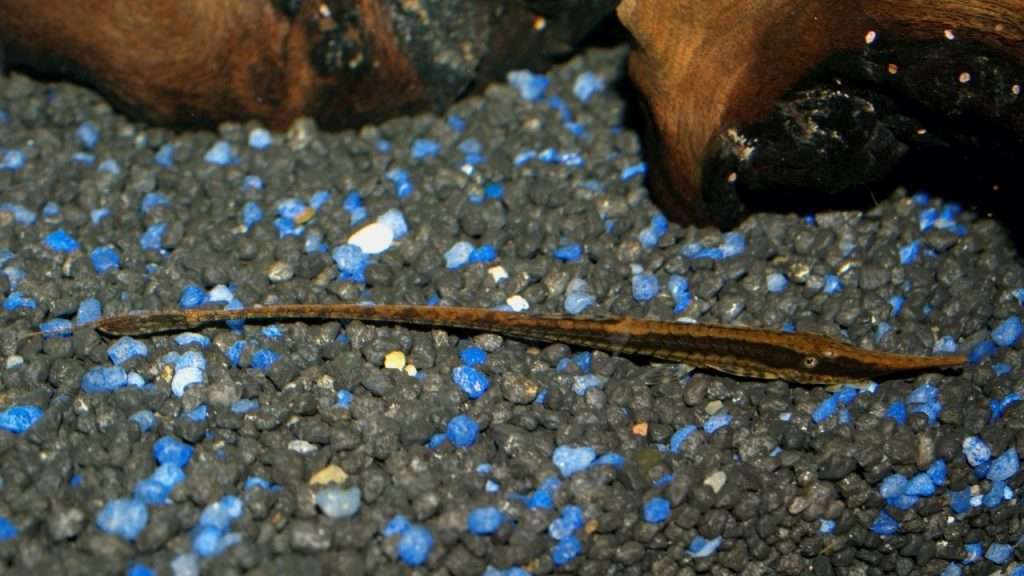
- Name / Scientific Name: Twig Catfish / Farlowella vittata
- Care Level: Moderate
- Temperament: Peaceful
- Maximum Size: 6 inches
- Minimum Tank Size: 50 gallons
- Diet: Omnivore
- Water Temperature: 73°-79° F
- dKH: 4-8
- pH: 6.0-7.0
As the name suggests, these prehistoric looking long thin fish look like twigs. They are sensitive to water parameter changes so definitely not beginner’s fish.
Peaceful to the point of being timid, they are tolerant of their own kind. The only time you’ll notice any squabbling between them is during mating season, but they never harm each other.
Due to their timid nature, aggressive and boisterous tankmates should be avoided.
A great choice for common green algae, they will clean it off almost any surface in your aquarium. They won’t touch brush or hair algae so you’ll need a different fish to eat that.
Besides algae wafers, other foods to feed them include blanched veggies like kale, cucumber, spinach, and the occasional bloodworm and daphnia will also be eaten.
Twig catfish prefer a planted tank with a soft sand substrate, so they don’t scratch their belly. Being shy and skittish they need plenty of places to hide so they feel safe.
If you’re looking for active fish, these aren’t for you as they spend most of their time staying perfectly still.
Algae Eating Shrimp
Shrimps are a great addition to your tank. They eat algae, biofilm, detritus, and leftover fish food and are cheap to buy unless you go for a fancy variety.
Shrimp won’t clear algae off your glass, so you’ll need a suitable fish or snail for that.
Dwarf shrimp can be a very tasty snack for fish, so don’t put small shrimp in with large fish. If the shrimp will fit in your fish’s mouth there’s a high chance it will eat it! Stick with small peaceful fish or a shrimp-only aquarium.
Shrimp are very sensitive to ammonia, nitrite, and higher levels of nitrate, so stable water parameters are essential.
12. Amano Shrimp
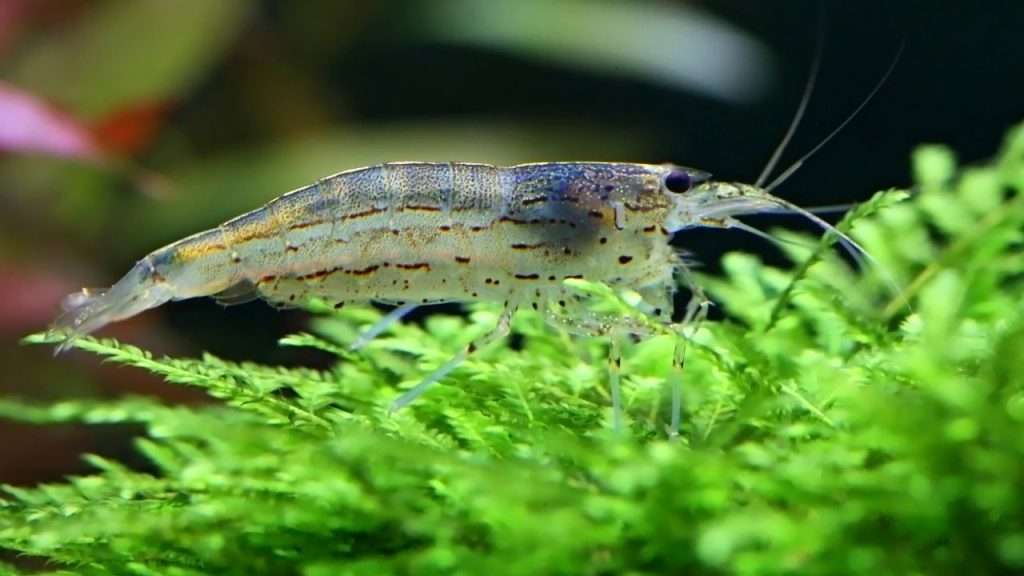
- Name / Scientific Name: Amano Shrimp / Caridina multidentata
- Care Level: Easy
- Temperament: Peaceful
- Maximum Size: 3 inches
- Minimum Tank Size: 10 gallons
- Diet: Omnivore
- Water Temperature: 70°-80° F
- dKH: 1-10
- dGH: 6-15
- pH: 6.5-7.5
- TDS: 100-400
A great shrimp to add to your tank as they’re able to adapt to a wide range of water parameters. They are very peaceful and sociable with their own kind and other species of dwarf shrimp, so need to be kept in groups.
They are known as the best algae-eating shrimp and will eat hair algae, brush algae, most types of string algae, and even the dreaded black beard algae.
As they can become a tasty snack for your fish, you will need to provide them with plenty of places to hide. You can buy shrimp tubes from your local fish store or online and they love to hide amongst plants, which also provide microorganisms for them to feed on.
Besides their ability to clear algae, they will also take care of any detritus and leftover fish food. They are quite greedy and will often dart out of their hiding place, grab a large chunk of food, and disappear back to their hiding spot.
You can supplement their diet with veggies like blanched zucchini and cucumber, as well as high-quality shrimp food if there isn’t enough algae to sustain them.
Shrimps molt as they grow and shed their exoskeleton, much like a snake sheds its skin when growing. The calcium in shrimp food will help their new exoskeleton develop.
Amano shrimps are notoriously difficult to breed, so they are not the best choice if you intend to breed Shrimp.
Females are larger than males and have a row of stretched dots across their bodies, whereas males have more distinct dots across their bodies.
13. Cherry Shrimp
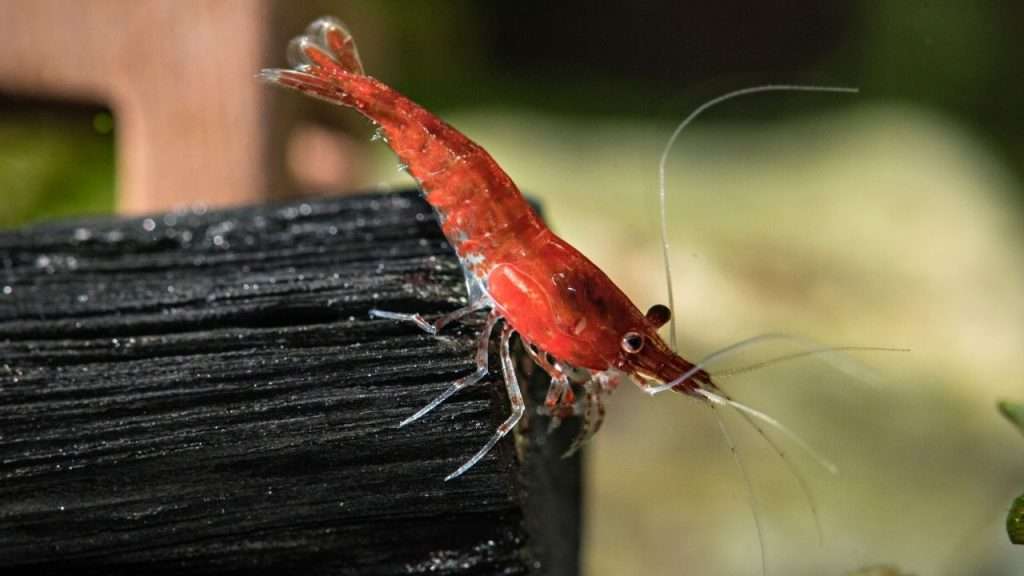
- Name / Scientific Name: Cherry Shrimp / Neocaridina davidi
- Care Level: Easy
- Temperament: Peaceful
- Maximum Size: 1.5 inches
- Minimum Tank Size: 5 gallons
- Diet: Omnivore
- Water Temperature: 65°-80° F
- dKH: 3-8
- dGH: 6-15
- pH: 6.5-8.0
- TDS: 180-250
Despite their name, cherry shrimp come in a wide range of colors including red, yellow, and blue. They’re able to adapt to a wide range of water parameters and are very peaceful, making them easy to care for.
They prefer to be in groups so I recommend at least 5 of them.
They’ll do a great job of eating your tank’s algae, but you’ll need to supplement their diet with high-quality shrimp food, blanched veggies, or sinking fish pellets.
Cherry shrimp are separated into ‘low grade’ and ‘high grade’ by fish stores and breeders based on their coloration. The more vibrant and intense their color, the higher grade they are.
This is based on nothing more than how the shrimp looks. It has nothing to do with its health, behavior, or expected lifespan.
Cherry shrimp are easy to breed as long as you have stable water parameters. Males are smaller and less colorful than females.
The shrimp fry will be a very tasty snack for fish, so there needs to be plenty of hiding spaces if they are in a community tank.
14. Ghost Shrimp
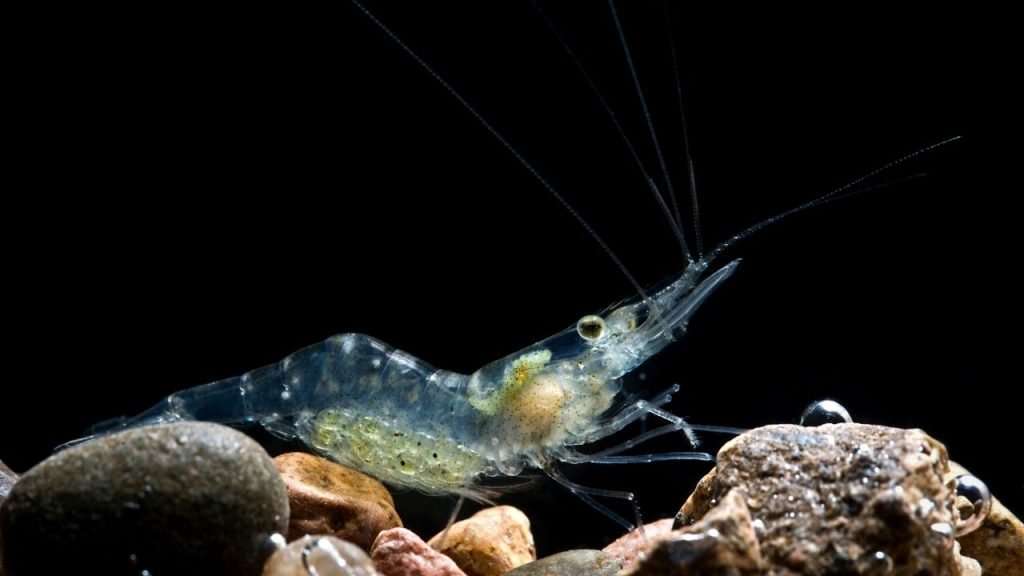
- Name / Scientific Name: Ghost Shrimp / Paleomonetes sp.
- Care Level: Easy
- Temperament: Peaceful
- Maximum Size: 2 inches
- Minimum Tank Size: 5 gallons
- Diet: Omnivore
- Water Temperature: 65°-80° F
- dKH: 1-7
- pH: 6.5-8.0
- GH: 6-15
- TDS: 100-400
Also known as the glass shrimp, the ghost shrimp is transparent and really fascinating to look at.
Ghost shrimp are often bred as cheap food for your fish, so they are not always bred in the highest quality conditions as they are not intended to survive for long! If you are buying ghost shrimp to survive, it’s best to get them from a reputable breeder.
Depending on their diet they can develop shading of orange, brown, beige, or yellow.
Like the other shrimp listed above, they can adapt to a wide range of water parameters, as long as they remain stable.
Not as good at eating algae as the Amano or cherry shrimp, but they will spend most of their time searching the tank’s substrate for any leftover food.
You should also feed them high quality shrimp food, algae wafers, and bloodworms.
The ghost shrimp can be slightly more aggressive than the Amano and cherry shrimp. They may fin nip slower swimming long-finned fish like bettas.
Algae Eating Snails
Snails will eat algae off your glass, rocks, plants, decorations…basically everything, so are a great addition to your tank.
To keep snails healthy they require harder water with a higher PH and enough calcium in their diet to keep their shell healthy.
If you notice that their shell is cracking or looks damaged, try adding a calcium block and supplementing their diet with dark green blanched veggies.
Some fish will eat snails, African cichlids, and loaches in particular, so do your research before adding them to a community tank.
Be careful which species of snail you add to your aquarium, I see lots of other websites recommending ramshorn and Malaysian trumpet snails for algae eating, but the reason I haven’t included them on my list is because they are prolific breeders and you can very quickly become completely overrun with them. Malaysian trumpet snails are parthenogenetic, meaning females can give birth without requiring contact with a male!
It’s recommended that you have a tight-fitting lid as snails are known escape artists.
15. Nerite Snail
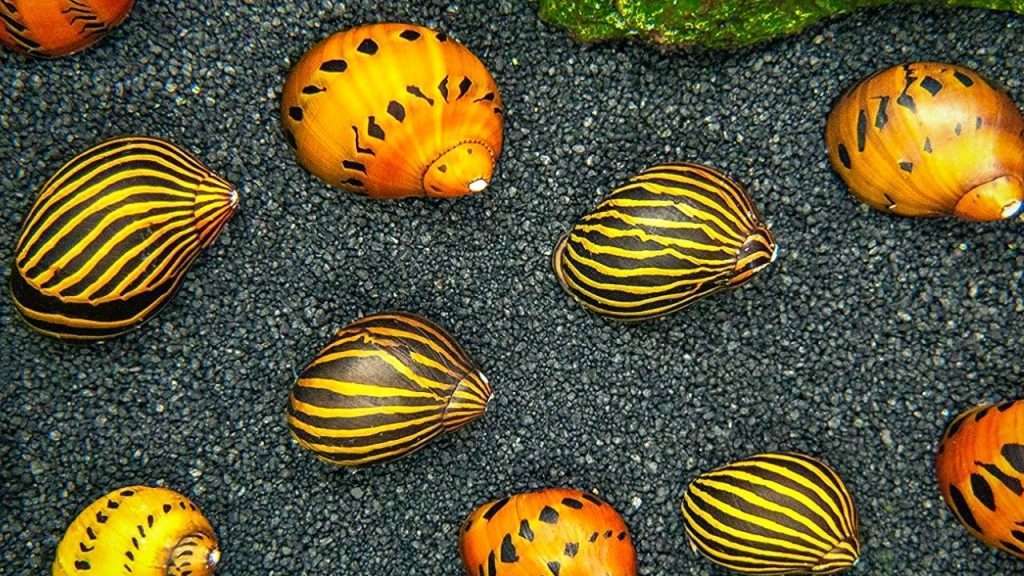
- Name / Scientific Name: Nerite Snail / Nerita sp.
- Care Level: Easy
- Temperament: Peaceful
- Maximum Size: 1 inch
- Minimum Tank Size: 5 gallons
- Diet: Herbivore
- Water Temperature: 72°-78° F
- dKH: 5-12
- pH: 7.5-8.5
These guys are known for obliterating algae, in particular Green spot algae (GSA).
Nerite snails come in a huge range of colors and shell patterns.
They are peaceful and safe to keep with fish and invertebrates and won’t eat your plants.
They will need their diet supplementing once the algae has been eaten. They particularly like algae wafers or blanched vegetables like zucchini, kale, or cucumber.
Nerite snails require brackish or salt water to reproduce, so you don’t have to worry about getting overrun with snails, like with some other species.
The female may lay tiny oval-shaped white egg capsules on most surfaces in your tank (they won’t hatch/survive in a freshwater tank), but they can look unsightly and can be difficult to remove.
16. Rabbit Snail

- Name / Scientific Name: Rabbit Snail / Tylomelania sp.
- Care Level: Easy
- Temperament: Peaceful
- Maximum Size: 5 inches
- Minimum Tank Size: 30 gallons
- Diet: Omnivore
- Water Temperature: 70°-84° F
- dKH: 2-15
- pH: 7.3-8.5
A very unusual looking snail that is sure to grab anyone’s attention who sees it in your tank. They come in a variety of colors, my favorite is the yellow rabbit snail.
They are very calm and peaceful, so they will get along with peaceful fish and invertebrates.
Rabbit snails, also known as elephant snails, are naturally inquisitive so can be seen meandering around your tank all day long eating algae and detritus, because of this they need a larger tank of around 30 gallons to give them plenty of space.
They are plant safe, although I have heard that they may munch on Java Fern.
You can supplement their diet with algae wafers, calcium-rich sinking fish food, and blanched vegetables.
You can breed rabbit snails fairly easily, but you will require a male and female as they are not hermaphrodites like a lot of other snails.
You don’t have to worry about them overrunning your tank, as they breed slowly (1-2 babies every 4-6 weeks). It’s really cool to watch the fully formed baby snail emerge from the small milky sac.
17. Mystery Snail

- Name / Scientific Name: Mystery Snail / Pomacea bridgesii
- Care Level: Easy
- Temperament: Peaceful
- Maximum Size: 3 inches
- Minimum Tank Size: 10 gallons
- Diet: Omnivore
- Water Temperature: 68°-84° F
- dKH: 12-18
- pH: 7.6-8.4
One of the most popular aquarium snails, they come in an array of colors so you are sure to find one you like.
They are peaceful and safe to keep with fish and invertebrates and won’t eat your plants.
They are great scavengers and will munch on algae, dead leaves, and detritus, keeping your tank in tip-top condition.
You can breed mystery snails fairly easily, but you will require a male and female as they are not hermaphrodites.
Make sure your water level is 3-4 inches below the rim of the tank, as the female will leave the water to lay a clump of eggs above the water’s surface.
The eggs will hatch in 2-4 weeks. If you don’t want the eggs to hatch simply remove them from your tank.
5 Tips For Beating Algae In Your Fish Tank
A clean-up crew is only part of the solution for dealing with aquarium algae. Here are my top tips to further help with algae control.
1. Test The Water
If you’ve got elevated levels of waste like fish poop and leftover food, this is providing nutrients for algae to feed off.
Testing the water regularly is the best way to spot if these levels are raised helping prevent an algae outbreak.
The API freshwater test kit offers outstanding value (over 800 tests!) and is very accurate, if you're serious about fishkeeping this is the best test kit to buy and the only one I use.
- Includes 7 bottles of testing solutions, 1 color card, and 4 tubes with caps.
- Performs over 800 tests.
- Accurately monitors the 5 most vital water parameter levels in freshwater aquariums: pH, high range pH, ammonia, nitrite, and nitrate.
- Helps monitor water quality and prevent invisible water problems that can be harmful to fish and cause fish loss.
- More time consuming than test strips
Perform water changes to reduce excess nitrates in the water.
2. Improve Water Flow
Place your filter in the middle of the tank rather than at the end. If you’ve got a tank that’s 5 feet or bigger with the filter at one end, you’re not cycling the water at the other end which allows nutrients and debris to build up.
If moving your filter isn’t practical, look at investing in an air stone and a pump for the opposite end of the tank or you could use a powerhead to get your water flowing around your aquarium better.
3. Reduce Lighting
Excess lighting is one of the main causes of algae buildup. Reducing the amount of time you have your aquarium lights on per day should help.
Use a timer to control exactly how much light your tank gets per day and gradually reduce the number of hours over time until you find your sweet spot, which is usually around 8-10 hours per day.
4. Tank Position
If possible, place your fish tank away from doors and windows to avoid direct sunlight.
It’s counterproductive to reduce the tank lighting to then bathe your aquarium in bright sunlight for several hours every day.
5. Add Some Live Plants
As we’ve now established light and excess nutrients in the water are what make algae grow, why not use those nutrients to grow aquarium plants instead?
Adding live plants has many benefits, they reduce nitrates, absorb carbon monoxide from the water, provide hiding spots for fish and they look great!
Best Freshwater Algae Eaters Summary….
By following these tips and choosing the best algae eater for your aquarium setup, you can reduce any excess algae naturally without having to reach for harsh chemicals to fix the problem.
If your tank is newly set up and you have an algae outbreak that looks like pea soup, there’s a good chance you are suffering from new tank syndrome and your tank isn’t fully cycled.
Check out the Aquarium Health section for guides on keeping your fish tank in tip-top shape.

